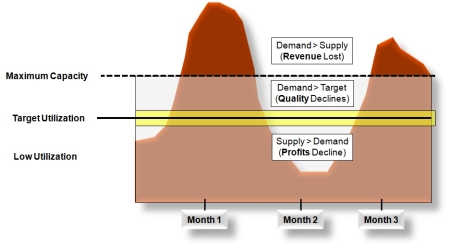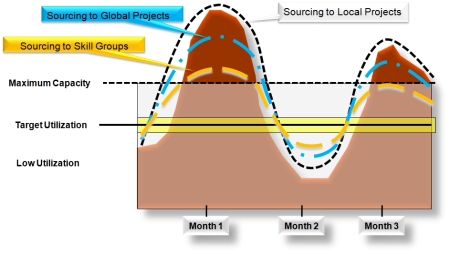In my post on The Science of Sourcing, I referenced a book by John Ricketts that applies the theory of constraints to the world of sourcing services. Since that post, several folks have commented on the challenges of applying this approach to their service organization. In my next post, I will discuss five specific reasons the next generation of sourcing process are challenging for embedded PS organizations to adopt. In this post, however, I want to reply to this great comment made by reader Richard Augugliaro:
“The obvious question is, how do you make sure that you know which skills are demanded? Again, doesn’t that have the same problem of relying on a Sales forecast as does the “Hire-to-Plan” model?”
The short response, is that there is no free lunch when working to optimize service sourcing. The more nuanced response is that forecasting skill requirements should involve less volatility than forecasting deals.
Ups and Downs
Sourcing human capital intensive service projects has always been challenging. Think of the startup consulting firm. They have two principals, beating the bushes for new opportunities. Suddenly, their business development efforts pay off in spades and three new projects hit at once. Unfortunately, they do not have enough hours in the week to deliver on all three projects. Do they turn down some of the business? Hire a sub-contractor to help deliver? This challenge of matching available resources to the ups and downs of signed projects is captured in the diagram below, which comes out of Mastering Professional Services.

Forecasting Service Demand
The Inability to Forecast
The challenge, as highlighted by Mr. Augugliaro’s comment, is forecasting. Can the service organization successfully forecast exactly when projects will hit? The basic answer is no. Despite the best sales forecasting tools and methodologies, the exact timing of when a service project will actually start is a bit of crapshoot. If this is a fundamental truth facing all project based service organizations, what is to be done? Simply leverage sub-contractors to help address the peaks and valleys of demand? This tactic clearly helps, but as a services organization becomes global, there are better tactics to employ.
From Local to Global
Managing the peaks and valleys of project demand at a local level is the most sub-optimal sourcing strategy a multi-regional services organization can pursue. We know that, on average, PS organizations that manage resources globally and not locally are more profitable. What’s the dynamic? PS organizations that are sharing delivery cycles across multiple geographies have the ability to slightly smooth out the peaks and valleys of demand that occur at a local level. OK, that big project in New York is delayed for a quarter. No problem, because we just signed a huge deal in London that can use the resources. Of course, there are challenges in sharing resources globally. Travel. Language. Expense. However, technology has helped lower those barriers and global resourcing has become a table stakes tactic for every large service provider. Especially when the service provider wants to leverage lower cost labor pools.
Sharing resources globally does not eliminate all the peaks and valleys in demand. What if every geography has an explosion of new projects? What if every geography experiences a downturn in demand? Sharing resources across geographies simply helps smooth out resource allocation when one geography is up and another is down.
From Projects to Skills
Sourcing projects on a global basis is one tactic to buffer the poor visibility related to the services forecast. But that is not the end game being promoted by Ricketts at IBM. He is arguing that service organizations need to go one step further by tracking the demand of specific skill sets. OK, we may not know when a specific project deal will actually be signed. In fact, forecasting is always a dicey proposition. Instead of building resource pools that align with shaky project forecasts, Ricketts argues service organizations should build buffers of “skill groups” that are matched to actual current demand. In essence, he is recommending the same just in time process leveraged by manufacturers working to minimize work in process inventories. When building a product, companies no longer produce mass quantities in advance and then hope they are able to sell the product—they adjust production based on real time market demand. Same concept here—except instead of producing the pieces of a finished products, service organizations are managing an inventory of raw skills required to deliver complex projects. This approach is more nuanced than simply forecasting skills, as implied by Mr. Augugliaro. This approach requires processes to understand the current availability of specific skill groups and how much “buffer” is available for each skill group. For the complete description of recommended techniques involved to accomplish the feat of managing service skill buffers, read “Reaching the Goal.”
The End Game
First a services organization sources projects on a local basis, with the resources close at hand. Forecasting is dicey, so there is always high risk that the local office will have too many or too few resources for the work that is actually signed. To offset this risk, the global services organization learns to share resource pools across local regions. This helps when one region has a spike in demand and another region is slow. However, forecasting exactly when projects will hit is still a difficult task and there is still risk the global organization may be sized incorrectly to meet actual project demand. Finally, the services organization starts to breakdown the specific skill groups being demanded by the marketplace on a global basis. The service organization understands what skills groups are fully utilized and what skill groups have excess capacity. Based on this data, the services organization tunes hiring (and downsizing) to meet actual market demand and builds a set of process for optimizing the amount of resources to have on hand. This is different than building pools of resources based solely onsales forecasts. To be clear, this model does require the services organization to maintain a bench of available resources to buffer spikes in demand. But the buffer is built around specific skill sets—not generic headcount in a specific region.
This migration from sourcing projects to sourcing skills, ideally, leads to a smoothing of the peaks and valleys in demand. Instead of attempting to source to the specific projects sold in a specific region (very lumpy), the services organization is sourcing to the global demand for specific skill sets (less lumpy). The image below maps this smoothing effect.

Sourcing by Skill Groups
Sourcing to skill groups (not projects) and optimizing skill buffers. Is this the silver bullet to kill the monster of poor sales forecasting? Is this the future of sourcing services? Or is this approach too complicated and we are simply destined to limp along, grumbling about that one deal that slipped away this quarter and cost us our quarterly bonus. Would love to hear thoughts on this topic.
Tags: IBM, skill buffers, sourcing services
August 12, 2009 at 5:11 pm |
While I certainly agree sourcing to skill groups is preferable, it requires a strategic change which also impacts culture. One of the major challenges common to most global companies is transfer pricing when talent is “loaned” to projects in different P&Ls. The manager “loaning” the talent now has an opportunity cost if the revenue recognition is not “equitable.” At the end of the day the local P&L owner must make the decision to source the additional talent locally or borrow it from another unit based on risk and cost.
August 12, 2009 at 8:20 pm |
[…] Service Visions Framing Technology Professional Services « Sourcing Services: Projects vs. Skills […]
September 11, 2009 at 1:19 pm |
I find the notion of “sourcing to skill groups” very intriguing in the context of global firms because the adoption of technology is not occurring concurrently and at the same pace globally. Some regions will lead while others will lag.
That being the case, do you see a gradual but steady migration of resources from regions where certain technologies have reached maturity and/or decline stages to regions where the technology is entering the growth stage?
Clearly there will be some organic growth of resources. In addition, some resources may decide to stay within their regions and hop on the next wave of technology.
Are global firms actively managing their resources to place them closest to where their skills meet demand? What are the trends?
June 7, 2010 at 7:39 am |
Thomas,
“…forecasting skill requirements should involve less volatility than forecasting deals….”
That one sentence tells every thing, thats the bottom line for me 🙂
James